The foreign relations of Norway are based on the country's membership in NATO and within the workings of the United Nations (UN). Additionally, despite not being a member of the European Union (EU), Norway takes a part in the integration of EU through its membership in the European Economic Area. Norway's foreign ministry includes both the minister of foreign affairs and minister of international development.

Buskerud is a county in Norway, bordering Akershus, Oslo, Oppland, Sogn og Fjordane, Hordaland, Telemark and Vestfold. The county extends from the Oslofjord and Drammensfjorden in the southeast to Hardangervidda mountain range in the northwest. The county administration is located in Drammen. Together with Akershus and Østfold, Buskerud will form the new, larger county Viken, from 1 January 2020.
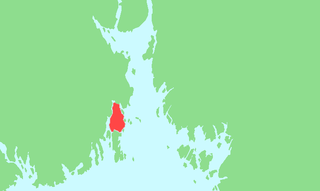
Nøtterøy is an island in Færder and a former municipality in Vestfold county, Norway. The administrative centre of the municipality was the village of Borgheim. The parish of Nøtterø was established as a municipality on 1 January 1838. Two islands were later transferred from the municipality of Stokke to Nøtterøy: Håøya and Veierland .

The national flag of Eritrea, ሃገራዊት ባንዴራ ኤርትራ as adopted on December 5, 1995, bears a resemblance to the official flag of the Eritrean People's Liberation Front. The wreath with the upright olive-branch symbol derived from the 1952 flag, which had a light blue background to honour the United Nations. The green color in the flag stands for the agriculture and livestock of the country, the blue represents for the sea, and the red for the blood lost in the fight for freedom.

The regions of Eritrea are the primary geographical divisions through which Eritrea is administered. Six in total, they include the Maekel/Central, Anseba, Gash-Barka, Debub/Southern, Northern Red Sea and Southern Red Sea regions.

Gash-Barka is one of the six regions of Eritrea. It is situated in the south-west of the country, bordering the Anseba region to the north, and the Maekel (Central) and Debub (Southern) regions to the east; the country of Sudan lies to the west and Ethiopia to the south.
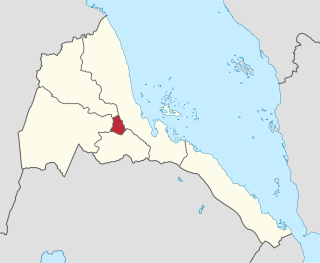
Central Region, also known as the Ma'ekel or Maakel Region, is an administrative region in central Eritrea. The region was formed on 15 April 1996, from the historical province of Hamasien. The region is located on the central plateau, and sits at an average of about 2,250 metres (7,380 ft) above sea level. It contains Asmara, the capital and largest city of Eritrea.

Debub Region, also known as the Southern Region, is a region of Eritrea. The region was formed on 15 April 1996, from the historical provinces of Serae and Akele Guzai. It lies along a portion of the national border with Ethiopia. As of 2005, the region had a population of 952,100 compared to a population of 839,700 in 2001. The net growth rate was 11.81 per cent. The total area of the province was 8000.00 km2 and the density was 119.01 persons per km2. The highest point in Eritrea, is Mount Soira 3,018 m (9,902 ft), is located in the region, situated east of Senafe. It shares borders with Central Region in the north, Zoba Northern Red Sea in the east, Gash Barka in the west and Ethiopia in the south. It is the largest region in the country by population.
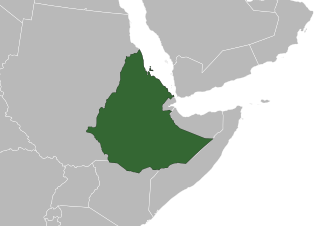
Habeshapeoples: Ge'ez: ሐበሻ /Habesha/ or /Abesha/ is a common term used to refer to both Ethiopians and Eritreans as a whole. Certain definitions considered the Ethiosemitic-speaking and Agwa-speaking Cushitic peoples inhabiting the highlands of Ethiopia and Eritrea as the core ethnic groups that historically constituted the pan-ethnic group Habesha peoples, while this notion is only partially accepted. They historically include a linguistically, culturally and ancestrally related ethnic groups, conservatively-speaking mostly from the Ethiopian Highlands, but in a broader sense included other Ethiopian-Eritrean ethnic groups as well. Members' cultural, linguistic, and in certain cases, ancestral origins trace back to the Kingdom of Dʿmt, the Kingdom of Aksum, among other kingdoms that either preceded or constituted the Ethiopian Empire in the Horn of Africa. Some Scholars have classified the Tigrayans and the Amhara as Abyssinians proper under an ultra-neo-conservative theory postulated by a few scholars and political parties but not widely accepted by the general public or by most indigenous scholars of the region.

Islam in Norway is a minority religion and the second largest religion in Norway after Christianity. As of 2018, Statistics Norway give a number of 166,861 muslims living in Norway or 3.15% of total population, although, the numbers varies in dependece of the source. So, the U.S. government statistics from the CIA registered 121.095 members of Islamic congregations in Norway, roughly 2.3% of the population, according to a 2011 estimation. The Pew Research Center estimated that 3.7% of Norwegians were Muslim in 2010 and 5.7% in 2016.
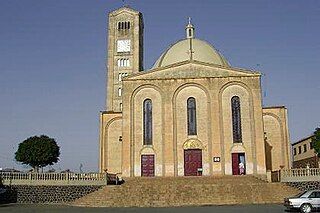
The Eritrean Catholic Church is a Metropolitan sui iuris Eastern particular church headquartered in Asmara, Eritrea. It was established in 2015 by separation of its territory from that of the Ethiopian Catholic Church and the setting up in that territory of a new sui iuris metropolitan Eastern Catholic Church. It follows the Ge'ez form of the Alexandrian liturgical rite.
The Tigrayans or Tigrinyas are an ethnolinguistic group indigenous to Northeast Africa who primarily inhabit the highlands of Eritrea and the Tigray Region of Ethiopia. They speak the Tigrinya language, a direct descendant of the Ge’ez language that was spoken in late antiquity.

The Ethiopian Catholic Church is a Metropolitan sui iuris Eastern particular church within the Catholic Church, established in 1930 in Ethiopia.
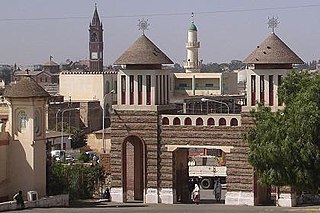
Religion in Eritrea mainly consists of Abrahamic faiths. Since May 2002, the Eritrean government has officially recognized the Eritrean Orthodox Tewahedo Church, the Eritrean Catholic Church, the Evangelical Lutheran Church of Eritrea, and Sunni Islam. All other faiths and denominations are in principle required to undergo a registration process; in practice they are not allowed to register. Among other things, the government's registration system requires religious groups to submit personal information on their membership to be allowed to worship.
In 2017, Norway's immigrant population consisted of 883,751 people, making up 16.8% of the country's total population. This includes both foreign-born and Norwegian-born with two foreign-born parents, and four foreign-born grandparents. In this population, 724,987 are foreign-born immigrants, while 158,764 are Norwegian-born with foreign-born parents. The ten most common countries of origin of immigrants residing in Norway are Poland (97,196), Lithuania (37,638), Sweden (36,315), Somalia (28,696), Germany (24,601), Iraq (22,493), Syria (20,823), Philippines (20,537), Iran (21,364) and Pakistan (19,973). The immigration population comprises people from a total of 221 countries and autonomous regions.
African immigration to Norway refers to immigrants to Norway from Africa. An estimated 97,152 people in Norway are either first or second generation immigrants from Africa.

Denmark–Ethiopia relations refers to the current and historical relations between Denmark and Ethiopia. Denmark has an embassy in Addis Ababa, and Ethiopia is represented in Denmark through its embassy in London. Diplomatic relations were established in the 1960s and since then the relations between Denmark and Ethiopia have had their ups and downs. In 2008, Ethiopian exports to Denmark amounted to 6,5 million DKK, while Danish exports amounted to 40,3 million DKK. Denmark provides aid and assistance to Ethiopia through the Danish International Development Agency (DANIDA). Ethiopia is a partner country for the DANIDA.
Eritreans in Norway are citizens and residents of Norway who are of Eritrean descent.















